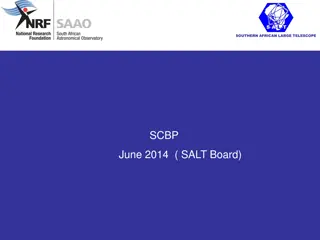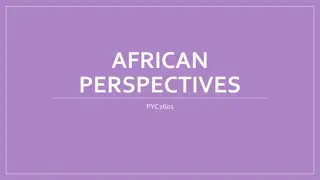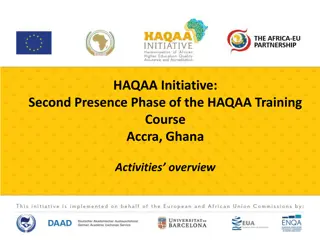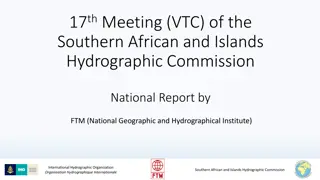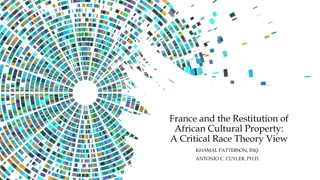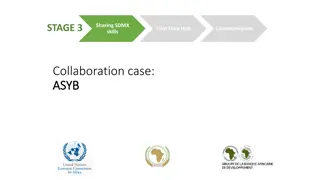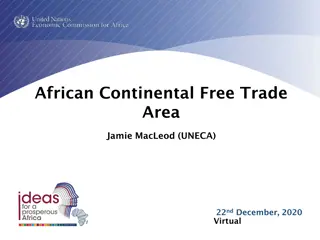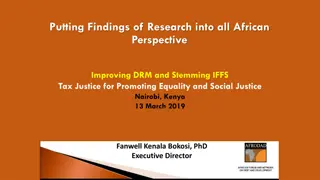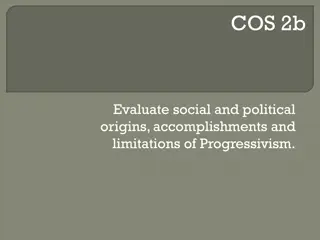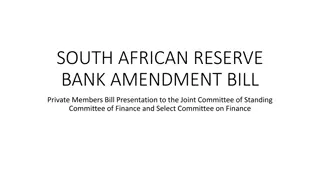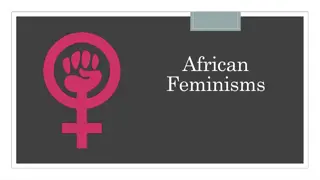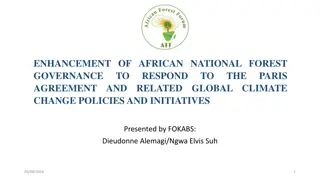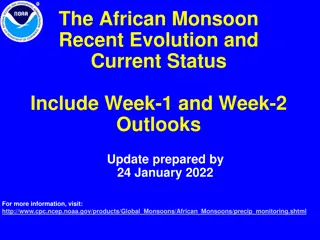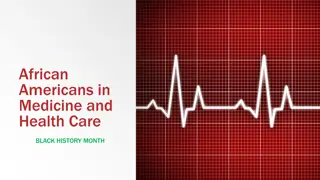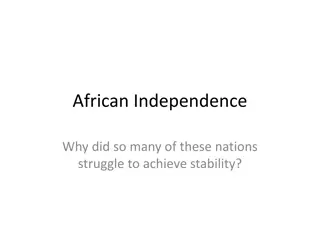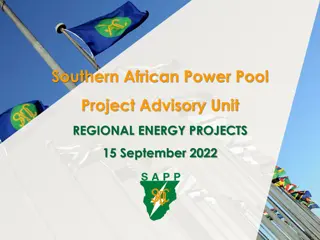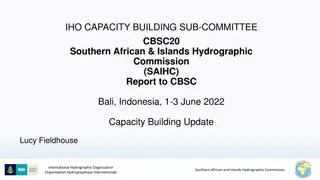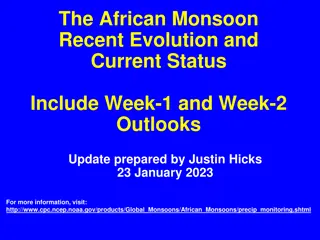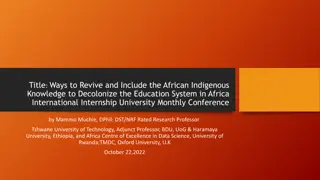Challenges and Opportunities in Southern African Education Policies and Economic Context
The discussion explores the transition from MDGs to SDGs in Southern Africa, focusing on the link between poverty and education quality. Emphasis has shifted towards ensuring inclusive, equitable, and quality education to improve learning outcomes by 2030. However, there is a surprising lack of policies addressing educational quality in the region. Economic disparities and varied educational responses further complicate the landscape.
Download Presentation

Please find below an Image/Link to download the presentation.
The content on the website is provided AS IS for your information and personal use only. It may not be sold, licensed, or shared on other websites without obtaining consent from the author. Download presentation by click this link. If you encounter any issues during the download, it is possible that the publisher has removed the file from their server.
E N D
Presentation Transcript
From MDGs to SDGs: Business as usual in Southern African? Servaas van der Berg Resep Stellenbosch/Bath University workshop 20 February 2020
From MDGs to SDGs Learning poverty inability to read and understand a simple text by age 10 links poverty and education as capability Major success of educational MDGs was rapid expansion of access Developing countries NER rose from 83 in 2000 to 91 in 2015; in Africa, from 52 in 1960 to 60 by 2000 and 80 by 2016 (UN 2015, 4) But progress in learning was disappointing: Education quality became an increasingly important focus, eg 2005 Education for All Global Monitoring Report s focus on The quality imperative . (UNESCO 2004) 2019 SDG report stated that an estimated 617 million children and adolescents of primary and lower secondary school age more than 55 per cent of the global total lacked minimum proficiency in reading and mathematics in 2015. (UN 2019, 30) Two-thirds of this was due to limited learning in schools (see also Taylor/Spaull) Thus shift in emphasis: Goal 4 of SDGs to Ensure inclusive and equitable quality education and promote lifelong learning opportunities for all , and especially in sub-goal 4.1, by 2030 to ensure that all girls and boys complete free, equitable and quality primary and secondary education leading to relevant and effective learning outcomes . (UN 2015). Emphasis on learning outcomes and equity were major departures from MDGs (Crouch and Gustafsson 2019)
Education policy in southern Africa Education policies and institutions overwhelmingly focus on expanding education Institutional response to increased resources is typically a deepening rather than qualitative change in education policy Surprising absence of policies focused on improving educational quality This seems equally true for education in most developing countries: Emphasis has shifted little from expanding access, with little attention to education quality This is despite efforts by international institutions (UNESCO, UN, World Bank) to improve and drastically expand measurement of cognitive outcomes expanded enrolment or
Economic context South Africa and its 6 neighbours share a common economic history All affected by recent weakening of SA economy through regional labour market and SA Customs Union (except Mozambique and Zimbabwe) Wide economic development range: Mozambique low income; Lesotho, Zimbabwe and Eswatini lower-middle income; Namibia, SA and Botswana upper-middle income Extreme poverty ranges between Namibia s 13% and Mozambique s 62% Expansion of enrolment creates varied education and institutional responses Share most features of developing countries Extreme poverty still above 40% in Eswatini, Lesotho and Mozambique (Zimbabwe estimate of 21% is probably incorrect or dated) SA and Namibia have extremely high inequality, with Zimbabwe s quite low Total fertility rates in SA and Botswana are markedly lower than the rest, yet still higher than in other upper-middle income countries. Mozambique s is extremely high Growth rate of school-age population high only in Namibia (1.5% p.a.) and Mozambique (2.3%) Low rate in the other countries may present opportunity for deepening investment per student
Southern African countries in perspective Poverty headcount ratio at $1.90 a day, 2015 Projected growth rate of population 6- 17, 2020-30 GDP per capita in current US$, 2018 Total fertility rate, 2015-20 Gini index, 2015 Botswana $8 259 16.1 % 53.3 2.9 0.8% South Africa $6 374 18.9% 63.0 2.4 0.5% Namibia $5 931 13.4% 59.1 3.4 1.5% Eswatini $4 140 42.0% 51.5 3.0 -0.2% Zimbabwe $2 147 21.4% 43.2 3.6 0.6% Lesotho $1 324 59.7% 54.2 3.2 0.6% Mozambique $ 490 62.4% 54.0 4.9 2.3% Sub-Saharan Africa $1 574 41.4% 53.3 4.7 2.0% Low income $ 813 45.0% 63.0 4.5 1.9% Lower middle income $2 219 14.1% 59.1 2.7 0.3% Upper middle income $9 200 1.6% 51.5 1.9 0.0% High income $44 715 0.7% 43.2 1.7 -0.3%
NERs and GERs Table shows NER and GER based on DHS and Aids Indicator Surveys (no data for Botswana) NER indicates whether children are enrolled at the right level For most recent year, primary NER is quite high most children enter and remain at primary school Compared to NERs, primary GERs total number of children of all ages in primary school expressed per 100 children in the population of primary school age are quite high because of late school entry, high primary repetition, and low primary drop-out Secondary NER strongly influenced by many children being over-aged due to repeating, or dropping out before high school Trends: Lesotho s primary NER rose from 85 to 94 between 2004 and 2014, GER fell marginally from 129 to 124, due to high repetition or late enrolment with limited primary drop-out. Higher NER and lower GER of girls is because they repeat far less than boys. Secondary NER doubled from 21 to 42 (51 for girls vs 34 for boys) Mozambique s primary NER rose from 60 to 74 between 2003 and 2015, eliminating gender difference. Secondary NER still low at 26. Inequality very high: only 15.1% of children aged 15-19 had completed grade 9 (urban 30.2%, rural 5.8%), large gap between richest and poorest household quintiles (40.5% vs 1.4%) (Filmer 2016) In Namibia, primary NER rose from 78 in 2000 to 84 in 2006/7. High primary GER reflects late enrolment and high repetition , affecting boys most. By 2006/7, secondary NER had risen to 53 for girls and 40 for boys SA s primary NER in 2016 DHS is lower than indicated by other sources, while high primary GER results from high repetition. Despite this, continuation to secondary is high, with secondary GER of 77 Zimbabwe s primary NER remained unchanged at 91 from 1999 to 2015, whilst GER fell from 125 to 108, reflecting declining repetition. Secondary NER rose from 43 to 50. Hardly any gender differences. Bashir, et al. (2018, 9) group 45 sub-Saharan education systems into four groups: Six of the seven countries are placed in Group 1, the Established group. In this group, the primary GERs are high in the baseline year (2000) and close to 100 percent circa 2013; the out-of-school rates for children of primary school age are low in the latest year of available data; and primary retention rates are close to 100 percent in 2013 . Mozambique is the exception: Categorised into Group 3, the Emerging group, where the GERs are low in the baseline year and high by circa 2013; the out-of-school rates for children of primary school age are high in the latest year of available data; and primary retention rates are low in 2013 . Surprising that this Southern African group contains 6 of the 13 Established African countries, given wide differentials within this group
Net and gross enrolment ratios derived from surveys Primary NER Primary GER Secondary NER Source Girls Boys Total Girls Boys Total Girls Boys Total Eswatini 2006-7 DHS 86 83 84 117 124 120 41 33 37 Lesotho 2014 DHS 95 92 94 119 124 121 51 34 42 Lesotho 2009 DHS 91 87 89 123 122 122 40 26 33 Lesotho 2004 DHS 87 81 85 127 129 128 27 16 21 Mozambique 2015 AIS 74 75 74 96 100 98 27 26 26 Mozambique 2011 DHS 75 74 74 98 105 102 23 24 24 Mozambique 2003 DHS 57 63 60 86 105 96 7 9 8 Namibia 2006-7 DHS 85 83 84 112 116 114 53 40 46 Namibia 2000 DHS 78 77 78 107 112 109 39 30 35 South Africa 2016 DHS 87 90 88 109 115 112 76 77 77
% of birth cohort that never entered school 90% Botswana Eswatini Lesotho Namibia Mozambique South Africa 80% 70% 60% 50% 40% 30% 20% 10% 0% 1930 1950 1970 1997 Birth year
% of birth cohort that completed primary school Botswana Lesotho Mozambique Zimbabwe Eswatini Namibia South Africa 100% 90% 80% 70% 60% 50% 40% 30% 20% 10% 0% 1930 1950 1970 1997 Birth year
Issues and policy responses I will discuss four issues and policy responses, drawing examples from these countries: Resources and priorities Serving remote communities Repetition, high stakes examinations and dropout Cognitive performance, testing and measurement
Resources and priorities Resource constraints bind strongly in all seven countries, even in Botswana One issue is balance between school and tertiary education, due to high tertiary education unit costs and high tertiary spending levels Within schools, many electives at secondary schools raise unit costs far above those in primary schools Zimbabwe: Fiscal constraints now so tight that most schools last received new textbooks in 2012 A new curriculum and a change in the LOLT in early years of primary school from English to Shangaan or Ndebele exacerbated textbook scarcity Strong emphasis on offering many electives raises secondary unit costs to four times primary levels High dropout also prevents economies of scale in some secondary schools
Resources and priorities (cont) Mozambique: Big issue is expansion of school system Civil war (1975-92) caused destruction or closure of 58% of schools (Mozambique Ministry of Education 1996, 40) Affected lagging regions most (Van der Berg, Da Maia and Burger 2017) FPE, greater financial support to schools, free textbooks, appointing more teachers and investment in classroom construction stimulated rapid enrolment growth, from 3.6 million in 2003 to 6.7 million in 2014 (UNICEF 2017) Clearly, supply side factors had held back expansion But expansion had serious implications for teacher quality Today, 12 291 schools offer grade 1, only 6 624 grade 7, 854 grade 8, and 435 grade 12 Hostels the main option for many rural students to attend secondary school Mozambique s priority is expanding the school system, but they face a lack of qualified teachers in rural areas Junior primary pupil-teacher ratio was 75 to 1 in 2006; appointing thousands of new teachers reduced this to 63 to 1 in 2011 (Mozambique Ministry of Education 2013, 27) Especially difficult to entice qualified secondary school teachers to teach in rural schools
Mozambique: Number of schools offering various grades, 2017 Enrolment by province and grade, 2017 In Zambezia: 3252 schools offer Gr1, only 85 Gr8, only 40 Gr12 Enrolment by province and grade, 2017 1 600 000 14 000 Cidade de Maputo Maputo 12291 12291 1224112068 1 400 000 12 000 Gaza 11387 Inhambane 1 200 000 Sofala 10 000 1 000 000 Manica Tete 8 000 7339 800 000 Zamb zia 6624 Nampula 600 000 6 000 Cabo Delgado Niassa 400 000 4 000 200 000 2 000 0 854 834 808 464 435 0 Gr1 Gr2 Gr3 Gr4 Gr5 Gr6 Gr7 Gr8 Gr9 Gr10 Gr11 Gr12 Source: Own calculations from Annual School Census (EMIS) 13
Resources and priorities (cont) Lesotho: Secondary school network has limited reach Ten times as many primary as secondary schools Primary NER 95 in 2009 97 for richest quintile and 91 in poorest Secondary NER much lower at 34 many children are behind/overaged due to late school entry and repetition many drop out before high school High education costs to parents and distance to schools reduce secondary access Fiscal pressure in providing textbooks and teachers, partly due to high salaries New curriculum adds to training and textbook needs; costs not really considered School feeding with international assistance at primary schools Despite high poverty, not in secondary schools Lack of secondary schools Expanding school network would be costly, with high costs of construction and teacher salaries. Recent report (World Bank 2019) makes case for extending grades offered in primary schools Eg some primary schools could become combined schools, adding grade 8 to 10 to their offering - this would reduce the cost of expansion by utilising existing facilities better
Resources and priorities (cont) Botswana Has more fiscal resources, but fiscal constraints have tightened Educational outcomes very unequal, but resource allocation between schools quite egalitarian 93% of variation in teacher numbers explained by enrolment, i.e. randomness index only 7% (though TIMSS data indicate some differentials in availability of textbooks and furniture) Primary PTR 26 to 1, secondary PTR 12 to 1 But class sizes often not small 90% of secondary students in classes with more than 32 students in their core subjects, one-third in classes of more than 40 students. In 2011 TIMSS Grade 9, average core class size was 37.6, standard deviation 8.4 Low PTR result of favourable fiscal situation and many electives at upper secondary level, thus large classes are split for electives (average secondary school teacher teaches only two hours per day) (World Bank/UNICEF/Ministry of Education and Skills Development 2020, 47) Full resource picture not as rosy Stark shortage of classrooms, 15% at primary level, even more at secondary level, especially for specialist classrooms Many classes take place under trees Shortage in part due to the budget for teacher salaries and for classroom construction being split between ministries Currently pressure to appoint even more teachers in the face of rising numbers of unemployed trained teachers Even a textbooks shortage: only two-thirds to three-quarters of required textbooks available (World Bank/UNICEF/Ministry of Education and Skills Development 2020, Table 19, 81) Eswatini PTR 31 to 1 in primary and 13 to 1 in secondary schools (Swaziland Ministry of Education and Training 2016, 14) Yet teacher allocation across schools not particularly equitable: Primary PTR ranges from 20 to over 60 (Swaziland Ministry of Education and Training 2016, 14) Primary teacher allocation had a fair degree of randomness in 2007 ( randomness index of 20%) (Bashir, et al. 2018, 258)
Serving remote communities Providing educational opportunities for children in remote rural communities is difficult in large and sparsely populated countries Botswana larger than France or Thailand, but population only 2 million compared to 82 and 66 million respectively Such factors make it difficult to bring schools close to the population and to attract teachers to rural areas In Kavango, half the schools offer education only up to Gr 4 or less (UNICEF 2015, Table 17, 71), so children need to move to new schools as they progress Mozambique faces similar problems due to the limited accessibility of secondary schools
Serving remote communities: Hostels or rented accommodation vs expanding school network Not always possible to bring schools closer to population Number of children may be too small Cost of constructing schools or providing teacher housing may be astronomical eg in desert regions of Namibia, water provision is often unpractical or prohibitively expensive At secondary level, ministries often prefer larger secondary schools that allow more electives This often necessitates hostels, which are expensive, and govts cannot always subsidise them A Namibian ParliamentaryCommittee heard that School hostels around the country are still faced with many challenges ranging from deplorable physical facilities, poor food preparation, lack of sanitation and poor hygiene . (UNICEF 2015, 73) In absence of hostels, many secondary students live in rented accommodation near schools, but this is expensive and conditions sometimes appalling Lesotho example Many children in mountain areas live far from high school, and transportation is limited or costly Cost for secondary student between US$650 and US$900 (hostel costs up to a quarter of this). Costs include various fees, textbooks/stationery and uniforms (World Bank 2019, 46) Consequently, secondary NER in richest quintile 61% vs 11% in poorest quintile (World Bank 2019, Table 11, 28) Currently, 11% of girls and 5% of boys in secondary schools live in school hostels, and a further 16% of both boys and girls in rented accommodation school authorities try to vet this One option is to extend primary schools to higher grades This would allow students to continue attending school to a higher level while still living in their own homes Also cheaper than building completely new schools, and saves the recurrent costs for maintaining school hostels But availability of qualified teachers may be a problem
Serving remote communities: Teacher assignment: Rural incentives versus deployment Two alternative models of teacher assignment: Deployment , a highly centralised system of allocation (eg Botswana, Mozambique) Decentralised system where teachers apply for advertised positions at a school (eg SA, Namibia) Incentives often provided to make remote schools more attractive Teachers usually frustrated with forced deployment to remote areas In Botswana, rural teachers complain about over-staying , where they are initially deployed in rural areas and after many years still do not get opportunities to move to more attractive locations Deployment is also sometimes socially disruptive, e.g. where husband and wife are deployed in different far- flung parts of this vast country Our study in Namibia concluded that incentives for teachers in remote schools may have helped to retain and attract qualified teachers We therefore proposed a modest rise in these incentives: This places a small additional burden on the education budget, raising incentive costs... This may further improve teacher allocation, signal to teachers in remote schools their contribution is valued, and be a sign to parents in such areas that the education of their children is a concern for the government . (UNICEF 2014, 9). Another recommendation was to provide more teacher housing in the most remote areas
Enrolment by grade and year 60,000 Botswana 45000 Swaziland 40000 50,000 35000 2009 30000 40,000 2010 2011 25000 30,000 2012 20000 2013 2007 2009 2011 2013 2008 2010 2012 2014 15000 20,000 2014 10000 2015 10,000 5000 2016 0 0 Grade 1 Grade 2 Grade 3 Grade 4 Grade 5 Grade 6 Grade 7 Form 2 Form 5 Form 1 Form 3 Form 4 std1 std2 std3 std4 std6 std7 std5 frm1 frm2 frm3 frm4 frm5 80,000 Namibia 70,000 60,000 50,000 40,000 2008 2009 2010 2011 2012 30,000 20,000 10,000 0 1 2 3 4 5 6 Grade 7 8 9 10 11 12
Repetition policy, high stakes exams and dropout Repetition in the literature International literature divided over repetition vs automatic promotion Much education research holds that grade repetition may increase the risk of negative life outcomes. Repeaters face potential stigma that may contribute to dropout No clear evidence that repetition improves learning, and it is expensive Automatic promotion should be accompanied by increased quality of other inputs and remediation to support low achieving students (Van der Berg, Wills, et al. 2019) Some evidence that automatic promotion reduces student efforts In developing countries, variation in student abilities in a class complicates teaching Grade promotion thresholds ensure that all students meet some minimal standard Yet repetition tends to increase age ranges within grades Repetition more common in developing countries, more in Francophone than Anglophone Africa Stronger limitations on repetition in Botswana and Zimbabwe than in other southern African countries
Repetition policy, high stakes examinations and dropout (cont) Zimbabwe Formally automatic promotion yet 25 000 primary (0.75%) and 12 600 secondary (1.2%) students repeated in 2018 (Zimbabwe Ministry of Primary and Secondary Education 2019) Repetition rates declining Boys more likely to repeat, specially in primary schools PSLE no longer high stakes All who write are promoted to grade 8, though only 80% of 2017 grade 7 students actually continued High stakes grade 11 O-levels exam much more severe: Determines access to senior secondary (grades 12 and 13) and into some colleges Most students fail, and fewer than one-quarter proceed to senior secondary Botswana Also automatic promotion, but with reservation Officially, children only repeat when parents agree that they should Grade repetition concentrated in earliest grades. In 2017, 14 000 primary (4.2%) and 719 secondary students (0.4%) repeated. (World Bank/UNICEF/Ministry of Education and Skills Development 2020, 49) High failure rates in grade 10 JCE limit numbers in senior secondary In 2014 the senior secondary GER was 62, NER only 29 (World Bank/UNICEF/Ministry of Education and Skills Development 2020, 9)
Eswatini Each year, 15% of primary learners are not promoted (UNICEF 2018, 11), despite official policy limiting repetition to 10% per grade per school (UNICEF 2016) Fewer than 10 000 on track in 2017, vs 30 000 in grade 1 six years earlier (2011) (UNICEF 2018, 38) Promotion rates in grades preceding external exams in grades 7, 10 and 12 as low as 60-70% Ministry officials ascribe this to accountability pressure on schools to perform in external examinations Weaker students are held back in the previous grade, which also encourages dropout The effect of high repetition rate with high dropout can be seen in Table Consider highlighted diagonal ( pseudo-cohort ) : Fewer students in grade 6 in 2010 than in grade 5 in 2009, due to dropout and repetition, but some of the grade 6 students in 2010 were repeaters from 2009, so not part of the original 2009 grade 5 cohort Following this diagonal, the grade 12) pseudo cohort in 2016 was less than 13 000, only 39% of the number in grade 5 in 2009 The second panel offers another way to follow a cohort: The cohort of 11-year old children in 2011 was reduced by dropout and repetition so that there were fewer 12-years olds in 2012, 13-year olds in 2013, and so on Of the original age cohort, only 63% were still in school at age 18, but many of these would have repeated one or more grades. Namibia Due to late enrolment and early repetition, 29% of grade 1 students are over-aged High repetition in primary and junior secondary grades raises over-age to 72% in grade 9, before it declines due to dropouts but is still 51% in grade 12 As part of a major curriculum change, the grade 10 examination, currently a high barrier, is being replaced by a grade 11 exam, regarded as the end of secondary school for most children. Those who wish to continue further, especially those with university ambitions, will have to write a new school- leaving examination at the end of the new grade 13
Swaziland: pseudo-cohorts vs actual cohorts 2009 2010 2011 2012 2013 2014 2015 2016 Grade 1 37 091 41 184 3 37 034 36 348 36 211 36 305 34 791 32 491 Grade 2 35 805 36 622 37 631 35 610 34 696 35 097 35 412 33 812 Grade 3 37 158 37 457 38 478 38 889 37 181 36 833 36 968 36 873 Grade 4 34 822 35 180 34 831 36 670 36 896 36 248 36 003 35 997 Grade 5 32 971 34 078 34 389 34 074 35 846 36 888 35 978 35 680 Grade 6 30 081 31 206 32 085 32 574 32 419 34 337 35 886 35 023 Grade 7 23 183 24 260 24 246 24 254 25 055 24 324 25 909 27 679 Form 1 22 059 23 800 24 784 24 940 25 448 26 975 27 080 27 664 Form 2 20 811 22 303 22 648 22 451 22 954 24 182 25 185 25 214 Form 3 14 343 14 952 14 179 13 994 15 077 14 185 15 549 16 873 Form 4 15 553 17 293 18 177 17 398 17 273 18 901 19 261 19 836 Form 5 10 307 10 626 10 556 11 093 11 144 11 134 12 007 12 753 Cohort 2011: Age 13 2012: Age 142013: Age 152014: Age 16 2015: Age 17 2016: Age 18 23 Enrolled 27 605 26 002 24 595 23 147 21 748 17 357
Enrolment by grade and year by incentive category Category 1 Category 3 Category 2 Category 4 24
Survival rates by incentive category, 2012 100% 90% 84% 80% 83% 67% 70% 70% 60% 58% 60% 50% 49% 40% 36% Category 1 30% Category 2 21% 20% 17% Category 3 10% 5% Category 4 1% 0% Grade 1 Grade 5 Grade 10 Grade 12 25
Repetition policy, high stakes examinations and dropout (cont) There are stronger limitations on repetition in Botswana and Zimbabwe than in other countries Zimbabwe Formally has automatic promotion, yet more than 25 000 children in primary and 12 600 in secondary schools repeated in 2018 (0.75% of primary, 1.16% of secondary enrolments) (Zimbabwe Ministry of Primary and Secondary Education 2019, Tables 8.1-8.3). Repetition rates have been declining Boys are more likely to repeat, specially in primary schools Primary School Leaving Examination, formerly a high-stakes examination that determined secondary access, no longer serves this function; all who write are promoted to grade 8, though only 80% of 2017 grade 7 students continued to grade 8 Effect of high stakes grade 11 O-level examinations much more severe: This determines access to senior secondary school ( grades 12 and 13) and into some colleges Most students fail this examination, and less than one-quarter proceed to senior secondary Botswana Also practices automatic promotion, but with reservation Officially, children only repeat when parents agree that they should Grade repetition concentrated in earliest grades. In 2017, 14 000 primary (4.2%) and 719 secondary students (0.4%) repeated. (World Bank/UNICEF/Ministry of Education and Skills Development 2020, 49) High failure rates in grade 10 JC Examination result in small numbers in senior secondary schools In 2014 the senior secondary GER was 62, the NER only 29 (World Bank/UNICEF/Ministry of Education and Skills Development 2020, 9)
Cognitive performance, testing and measurement To improve educational outcomes in line with Goal 4.1 of SDGs requires measuring and monitoring cognitive outcomes Regular participation in international assessments offers a convenient way to do this Analysis of such data can offer insights into shortcomings, thus informing policy SACMEQ is the only such international assessment that all 7 countries participate in But SACMEQ only takes place at quite long intervals and last released data is for 2007 Botswana and SA sometimes on occasion participate in other international assessments Gustafsson (2012) used all international cognitive evaluations available in 2012 to convert country average scores to a common Pisa scale . The Pisa setpoint (average) was originally set to 500 with a standard deviation of 100. Lesotho and Namibia performed more than two standard deviations (roughly equivalent to 5 years of learning) below this Pisa setpoint. Even Eswatini and Botswana performed more than 1.3 standard deviations below the Pisa setpoint. Assuming a year s learning to be 40% of a standard deviation, the average student in these countries is 3 to 6 years behind students in the average Pisa country. The extremely low TIMSS and PIRLS scores of Botswana and SA confirm the large gap to developed countries It will require many decades to achieve education quality similar to that in developed countries today
Pisa scale scores for a selection of countries (based on Gustafsson, 2012) Country Malawi Lesotho* Namibia* South Africa* Ghana Mozambique* Zimbabwe* Botswana* Eswatini* Brazil Kenya Chile Malaysia United States England Germany Finland Pisa scale score 260 288 289 317 331 332 345 367 368 387 388 407 437 485 487 491 543
Cognitive performance, testing and measurement (cont) South Africa In 2012 DBE introduced Annual National Assessments (ANA) testing all children in grades 1 to 6 and in grade 9 in language and maths Tests were nationally set but administered by schools This offered the potential of providing information on student performance and on specific weaknesses in learning by school, thus the National Development Plan saw the ANAs as a potentially important monitoring and accountability tool. However, there were reservations about test quality (calibration), a capacity issue An even bigger problem was fierce teacher union opposition, especially to the accountability aspects, which led to ANAs abolition in 2015 After long negotiations between unions and govt, there are now plans for sample-based systemic evaluations to provide information about system performance in grades 3, 6 and 9, but these would not provide the school-level results needed for accountability This is particularly needed at the primary level, as SA is one of only a few countries in southern Africa without a standardized primary school exam In President Ramaphosa s 2019 state of the union address, he committed the government to the goal that every child should be able to read for meaning by age 10 This is in harmony with the SDGs and with international efforts to eliminate learning poverty by acknowledging the reality of weak learning outcomes Yet there is little indication that the government will be measuring and monitoring progress to this goal
Cognitive performance, testing and measurement (cont) Botswana Although richest in SACMEQ, it performs near average Poor children perform particularly badly Gap between poorest quarter and the average almost as large as in SA Performance in TIMSS and PIRLS far below middle-income average Weak PIRLS performance indicates that learning deficits start early No improvement in internal examinations in recent years (World Bank/UNICEF/Ministry of Education and Skills Development 2020, 9-10, 12) A report for the education ministry found school monitoring and support services to be ineffective, and stated that the country has made little progress in producing an assessment system that enables the government to monitor at a national level what the quality of the national education outcomes are. (Botswana, Ministry of Education and Skills Development 2014, 40) The three national examinations and international assessments are not systematically used to inform policy to assist teachers or direct in-service training Little information on performance in grades that do not have standardised examinations (World Bank/UNICEF/Ministry of Education and Skills Development 2020, 72)
Cognitive performance, testing and measurement (cont) Eswatini Scored higher than the other 6 countries in SACMEQ 2007 High repetition rates may perversely have contributed to this, by weeding out weaker students (UNICEF 2018, 12) Social gradient, measured as score difference between poorest and richest quarter of participants, only 18 points in Maths and 39 in Reading (standard deviation across all SACMEQ countries 100 points) In contrast, these differentials are a massive 119 and 159 in SA and 70 and 83 in Zimbabwe (Spaull 2012) Mozambique Mozambique SACMEQ performance in 2007 fell by more than 40 points (40% of std dev) in both Reading and Math Massive enrolment growth brought more poor pupils into schools, increased resource pressure Despite large increase in weak performers that caused the average decline, there was also growth in numbers performing at higher levels (Taylor and Spaull 2015) Service Delivery Indicator survey by World Bank showed severe teacher issues 45% of primary teachers absent from school on day of survey, another 21% not in class teaching thus only one-third of teaching time available for teaching Absenteeism amongst school directors (principals) 44% Teachers have poor subject knowledge only 60% of lower-primary teachers could provide correct answer to a simple subtraction question, 86 minus 55 Teacher pedagogy weaker than in other African countries that had SDIs (Molina and Martin 2015) Absenteeism amongst children also a problem Portuguese comprehension test for a grade 3 sample in 2016 found least half the students were absent in one quarter of schools tested (Mozambique, Minist rio de Educa o e Desenvolvimento Humano, Institute Nacional de Desenvolvimento da Educa o (INDE) 2017) Especially large absenteeism in Central region, one of the most disadvantaged and a weak performer
Cognitive performance, testing and measurement (cont) Zimbabwe Low stakes test in Gr7 (PSLE), high-stakes in Gr11 (O-levels) and Gr13 (A-levels) 100% 88.9% 90% 83.3% 80% 70% 70.5% 60% 52.9% 50% 40% 32.8% 30% 32.9% 20% 11.9% 10% 0% 2007 2008 2009 2010 2011 2012 2013 2014 2015 2016 2017 2018 (MoPSE 2018, Primary and Secondary Education Statistics Grade 7 O-level A-level Zimbabwe Early Learning Assessment (ZELA) shows significant improvement between 2012 and 2018 in standardized tests in Gr3 in both English and Maths in registered and satellite schools
Conclusion Policy shows strong emphasis on access, little on cognitive outcomes Implicitly presumed more of the same will improve learning: Textbooks, teacher training, ICT, laboratories Few attempts to see whether training actually improves teaching or learning, or if textbooks are used Little enthusiasm for participation in international tests Available test data not used to inform teaching practice or training Internal school assessments or standardised exams used as measure of learning International community has shifted emphasis from access to cognitive outcomes and equity but this is getting scant attention in education ministries in southern Africa Learning poverty is still widespread, but largely ignored As ministries often measure performance in terms of pass rates, limiting access of weak students to examins is widely practiced This makes rapid progress in learning outcomes unlikely That schooling ain tlearning (Lant Pritchett) has not yet sunk in in most southern Africa countries The same probably applies in many other developing countries, especially poorer ones: Large schism between insights of international community (UN organisations, World Bank) and policies and practices of many developing countries (often supported by some development partners) Easier to get support for implementing a new curriculum than to test regularly, or to use results for accountability purposes While 2030, the SDG target date, is getting closer, the fundamental shifts in the educational development goals from MDGs to SDGs has not yet sunk in as an integral part of education thinking, policy and practice
% of birth cohort that completed various grades A: Grade 5 B: Grade 7 Botswana Lesotho Namibia South Africa Swaziland Botswana Lesotho Namibia South Africa Swaziland 100% 100% 90% 90% 80% 80% 70% 70% 60% 60% 50% 50% 40% 40% 30% 30% 20% 20% 10% 10% 0% 0% 1930 1935 1940 1945 1950 1955 1960 1965 1970 1975 1980 1985 1990 Birth year 1930 1935 1940 1945 1950 1955 1960 1965 1970 1975 1980 1985 1990 Birth year C: Grade 10 D: Grade 12 Botswana Lesotho Namibia South Africa Swaziland Botswana Lesotho Namibia South Africa Swaziland 100% 60% 90% 50% Note exaggeration 80% 70% 40% 60% 50% 30% 40% 20% 30% 20% 10% 10% 0% 0% 1930 1935 1940 1945 1950 1955 1960 1965 1970 1975 1980 1985 1990 Birth year 1930 1935 1940 1945 1950 1955 1960 1965 1970 1975 1980 1985 Birth year
Lesotho: % of birth cohort that have reached Grades 1, 5, 7, 10 & 12 100% Gr1 90% 80% Gr5 70% 60% Gr7 50% 40% Gr10 30% 20% Gr12 10% 0% 1930 1940 1950 1960 1970 1980 1990 Year of birth
Namibia: % over-aged for grade (older than 7 in grade 1, 8 in grade 2, etc.) 80% 72% 71% 70% 66% 63% 63% 63% 60% 56% 54% 51% 49% 50% 42% 40% 29% 30% 20% 10% 0% 1 2 3 4 5 6 7 8 9 10 11 12 Grade 36
Lesotho: Districts enrolment by grade, 2016 60 000 50 000 40 000 Enrolment by grade and district, 2016 & Net enrolment by quintile and gender, 2009 30 000 20 000 10 000 0 std1 std2 std3 std4 std5 std6 std7 frm1 frm2 frm3 frm4 frm5 THABA-TSEKA BUTHA-BUTHE LERIBE BEREA MASERU MAFETENG MOHALES HOEK Primary net enrolment rate QUTHING QACHAS NEK MOKHOTLONG Secondary net enrolment rate Male Female 6.7 14.8 15.3 27.1 24.9 38.1 37.0 51.6 59.9 61.8 28.8 38.7 Male 87.0 90.4 94.2 94.5 97.8 92.8 Female 94.3 97.2 96.7 98.0 97.0 96.6 Total 90.5 93.8 95.4 96.2 97.4 94.7 Total 10.7 21.0 33.2 44.4 61.0 34.1 Quintile 1 Quintile 2 Quintile 3 Quintile 4 Quintile 5 Total 37


